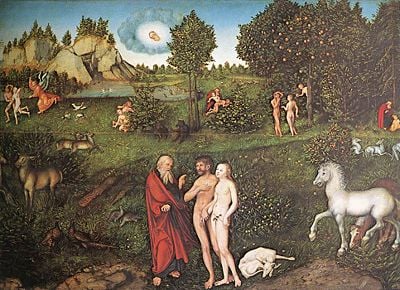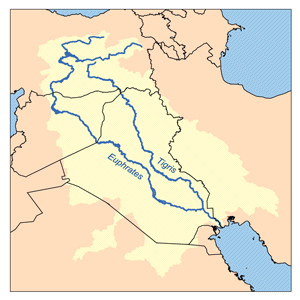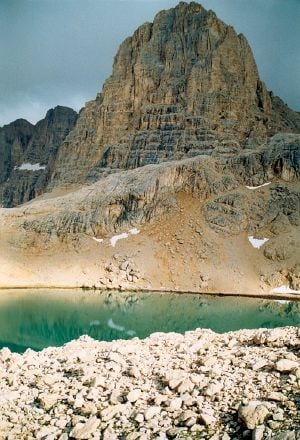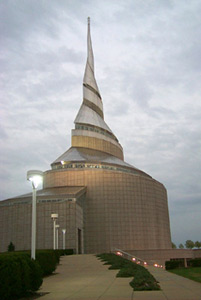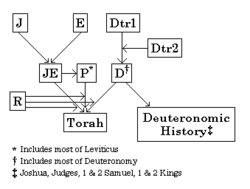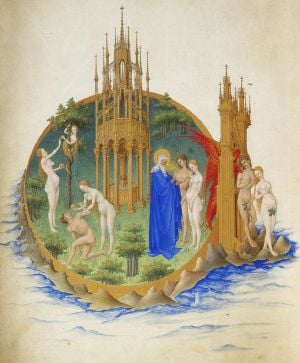Difference between revisions of "Garden of Eden" - New World Encyclopedia
m (→References) |
m (→References) |
||
| Line 98: | Line 98: | ||
==References== | ==References== | ||
| + | *Delumeau, Jean and Matthew O'Connell. ''History of Paradise: The Garden of Eden in Myth and Tradition''. University of Illinois Press; New Ed edition, 2000. ISBN 978-0252068805 | ||
| + | * Lacocque, Andre. ''The Trial of Innocence: Adam, Eve, and the Yahwist''. Wipf & Stock Publishers, 2006. ISBN 978-1597526203 | ||
| + | * [[Morris, Henry M.]] ''The Genesis Record: A Scientific and Devotional Commentary on the Book of Beginnings''. Baker Books, 1995. ISBN 9780801060045 | ||
| + | * Pagels, Elaine.''Adam, Eve, and the Serpent''. Vintage, 1989. ISBN 978-0679722328 | ||
| + | * Ratzinger, Joseph Cardinal (now [[Pope Benedict XVI]]). ''In the Beginning''. Wm. B. Eerdmans Publishing Co, 1995. ISBN 978-0802841063 | ||
| + | * Schearing, Linda S. ''Eve & Adam: Jewish, Christian, and Muslim Readings on Genesis and Gender''. Indiana University Press, 1999. ISBN 978-0253212719 | ||
==External links== | ==External links== | ||
Revision as of 19:59, 24 September 2007
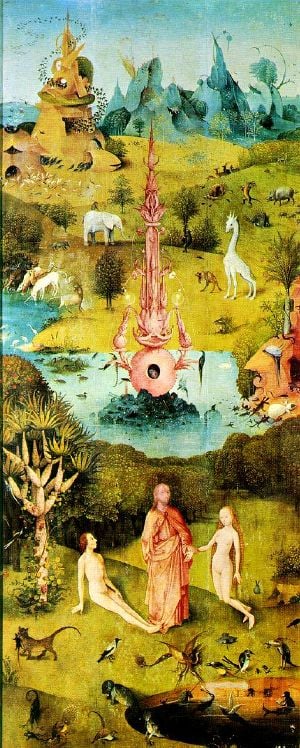
The Garden of Eden (from Hebrew Gan Eden) is described by the Book of Genesis as being the place where the first man and woman—Adam and Eve—lived after they were created by God until their expulsion for disobedience. The origin of the term "Eden," which in Hebrew means "delight," may be related to the Akkadian edinu, which derives from the Sumerian E.DIN. The latter words mean "plain" or "steppe."
Eden is described as a paradise where the first human couple lived naked unshamed and where God Himself walked, talked, and interacted directly with His creations. In the Garden, humans did not need to work, but lived on whatever vegetables and fruits they wished to eat. However, one particular fruit—from the Tree of Knowledge of Good and Evil—was forbidden to them, for it would cause them to die. The animals posed no threat to them, again with one major exception: a talking serpent which tempted the first woman to eat of the forbidden fruit.
The Genesis account supplies the geographical location of Eden in relation to four major rivers, two of which exist today: the Tigris and the Euphrates. However, the true location of Eden is the subject of much speculation. Many believe that Eden was not an actual physical location, but a state of mind from which mankind fell because of sin.
Eden is recognized in the three Abrahamic religions of Judaism, Christianity, and Islam. Some other religions and cultures have a creation story containing a similar concept to the biblical Garden of Eden, ascribing various locations to the place of first habitation.
Biblical account
The tale of the Garden of Eden story is found in Genesis 2-3. God, called Yahweh, creates Adam from the "dust of the ground" when "no shrub of the field had yet appeared on the earth and no plant of the field had yet sprung up." Yahweh then plants the Garden of Eden and places Adam there. After this, Yahweh causes trees to grow in the Garden, including the special Tree of Life and the Tree of Knowledge of Good and Evil. From the latter tree alone Adam is commanded to refrain from eating, on pain of death. Seeing that Adam was alone, Yahweh decides to make a helper for him. He creates the animals and brings them to Adam, who gives them names. However, none of them is an adequate mate for him. Yahweh then creates a female out of Adam's own body. Adam names her "woman." Both of them are naked and without shame.
Despite its paradise-like character, the Garden of Eden is not an entirely safe place. A talking serpent appears on the scene and begins to tempt the woman to eat of the forbidden fruit of the Tree of Knowledge of Good and Evil. She resists, for she understands that she and Adam have been commanded not to eat of this fruit. However, the serpent convinces her that they will not die by eating it, and shows her that the fruit is "good for food and pleasing to the eye, and also desirable for gaining wisdom." She eats of it, and gives some to Adam. As a result, "the eyes of both of them were opened" and they realize that they are naked. They feel ashamed of themselves and cover their sexual areas with fig leaves. They also begin to fear Yahweh because of their nakedness.
Yahweh walks through the Garden and looks for the couple but cannot find them. When he discovers them hiding, they reveal their shame over being naked, and Yahweh realizes they have eaten of the forbidden fruit. Although they do not die, as Yahweh had predicted they would, the consequences of their actions are dire indeed. Yahweh curses the serpent to crawl on its belly and eat dust. He curses the woman—who is still unnamed—to painful childbirths and to be subservient to her husband. He curses the land on account of Adam's sin. And He curses Adam to live by arduous labor, "for dust you are and to dust you will return." (Gen. 3:19)
Only then does Adam finally give the woman a name, Eve, meaning "the mother of all living."
After this, Yahweh makes garments for Adam and Eve, but condemns them to live outside of the Garden of Eden. To prevent the couple from eating of the Tree of Life and living forever, he drives them out of the Garden and places two cherubim and a flaming sword at its entrance, "flashing back and forth to guard the way to the Tree of Life."
Other Biblical references
The Garden of Eden is rarely referred to outside the first chapters of Genesis. In 2 Kings 19 (repeated in Isaiah 37), the Assyrian king Sennarchib boasts of his having defeated the "children of Eden" at tel-Assar, thought to be located west of the Euphrates about 145 km south of modern Haran.
Eden is mentioned several times in the Book of Ezekiel, who speaks of the "trees of Eden" as a metaphor of fallen greatness:
The prophet Joel refers to Eden as a metaphor of the current state of affairs compared to the coming doom:
- Like dawn spreading across the mountains a large and mighty army comes..
- Before them fire devours, behind them a flame blazes.
- Before them the land is like the garden of Eden,
- behind them, a desert waste—nothing escapes them. (Joel 2:2-3)
The New Testament does not mention Eden by name. However, Jesus is referred to as a new "Adam," (1 Cor. 15:44), and the Book of Revelation quotes Jesus as promising: "To him who overcomes, I will give the right to eat from the Tree of Life, which is in the paradise of God." (Revelation 2:7) Revelation identifies this paradise as a highly civilized place—the New Jerusalem—rather than a primordial garden. It is described as the "Holy City... coming down out of heaven from God," in which the Tree of Life is situated, and the "River of the Water of Life, as clear as crystal," flows from the throne of God.
Location
The Book of Genesis contains little information on the Garden of Eden itself beyond the above account. However, in terms of the Garden's location, some fairly specific information is given.
| “ | A river watering the garden flowed from Eden; from there it was separated into four headwaters. The name of the first is the Pishon... The name of the second river is the Gihon; it winds through the entire land of Cush. The name of the third river is the Tigris; it runs along the east side of Asshur. And the fourth river is the Euphrates. | ” |
The identity of Pishon and Gihon have been the subject of endless argument, but if the Garden of Eden had really been near the sources of the Tigris and the Euphrates, then the original narrators would have identified it as located generally in the Taurus Mountains of Anatolia (in today's Turkey).
Alternate locations
A number of other claims as to the geographic location of the Garden of Eden. The first century C.E. Jewish historian Josephus and several early Church Fathers believed the Pishon to be one of the rivers of India, while Cush is Ethiopia and thus the Gihon is the Nile. In the Talmud, Resh Laḳish states: "If the paradise is situated in Palestine, Beth-Shean is the door; if in Arabia, then Bet Gerim is the door; and if between the rivers, Damascus is the door." ('Erubin 19a) In another part of the Talmud (Tamid 32b) the interior of Africa is pointed out as the location of Eden, and no less a personage than Alexander the Great is supposed to have found the entrance of the Garden in African regions which are inhabited and governed exclusively by women.
John Calvin and others believed the Shatt al-Arab—formed by the union of the Tigris and Euphrates near the Persian Gulf—to be the river that "went out of the Garden."
Some historians dealing with ancient Sumer, where the earliest surviving non-biblical sources of the Eden legend may lie, point to the Bronze Age commercial center of the island Dilmun (now Bahrain) in the Persian Gulf, described as "the place where the sun rises" and "the Land of the Living." After its decline, beginning about 1500 B.C.E., Dilmun developed such a reputation as a long-lost garden of exotic perfections that some theorists believe it influenced the story of the Garden of Eden.
Various African locations have been suggested on the basis that human life is believed to have originated there, according to scientific theories. In addition, locations as diverse as Ethiopia, Java, Sri Lanka, the Seychelles, and Bristol, Florida, have all been proposed as locations for the Garden. One recent claim by archaeologist, David Rohl, puts the Garden of Eden in northwestern Iran. According to his findings, the Garden was a river valley east of Sahand Mountain, near Tabriz. He cites several geological similarities with biblical descriptions and multiple linguistic parallels as proof.
There is also an attempt to tie the location of Eden with the mystical sunken land of Atlantis. One suggested location of this Eden is Sundaland in the South China Sea. In this theory, the current Tigris and Euphrates rivers are not be the ones referred to in the narrative, but are later rivers named after two of the earlier rivers, just as in more modern times colonists named features of their new land after similar features in their homeland.
In Latter-day Saint (Mormon) theology, the Garden of Eden is believed to be located at what is now inside the city limits of Independence, Missouri. Latter Day Saints believe the configuration of the continents was different before the Great Flood and that the geographical descriptions of Eden in Genesis refer to lands and rivers that were later renamed after the Flood.
The Urantia Book (1955), a channeled revelation supposed to come from angelic beings, places the Garden of Eden in a long narrow peninsula projecting westward from the eastern shores of the Mediterranean which was long ago submerged in connection with volcanic activity.
Some contemporary theologians believe that the Garden never had a terrestrial existence, but was instead an adjunct to heaven as it became identified with Paradise. Others take the story allegorically, seeing Eden as a psychological state rather than any physical location.
Biblical literalists answer that even though Eden may not exist today, it did once exist just as the Bible says it did. Since the world of Eden's time was destroyed during Noah's Flood, it is impossible to identify Eden's physical location today.
Eden as Paradise
The word "paradise," often used as a synonym for the Garden of Eden, is originally a Persian word, which describes a walled orchard garden or an enclosed hunting park. In the post-Exilic apocalyptic literature and in the Talmud, "Paradise" became associated with the Garden of Eden and its heavenly prototype. Jesus reportedly told one of the thieves who died with him on the cross that: "Today you will be with me in Paradise." (Luke 23:43) Saint Paul spoke of Paradise as a heavenly realm which can be experienced spiritually by people still alive on earth (2 Corinthians 12:4).
In Rabbinical literature. both the Talmudists and kabalistic rabbis agree that there are two gardens of Eden: one, the terrestrial, of abundant fertility and luxuriant vegetation; the other, celestial, the habitation of righteous, immortal souls. These two are known as the "lower" and "higher" Gan Eden.
Critical views
Biblical critics point out that the story of the Garden of Eden is clearly mythological and also that it contradicts the earlier version of Creation given in Genesis 1.
In the story of Eden, Adam is Yahweh's first creation, formed from dust even before the plants and animals. Eve, on the other hand, is created last of all. However, in Genesis 1, the unnamed first man and woman are created simultaneously on the sixth day of creation, only after God (called Elohim) creates the plants and animals. Genesis 1 describes a world in which Elohim gives only blessings and no commandments; nor is there any serpent to tempt the first couple. Genesis 2-3 presents the world as a dangerous place, in which a tempting poisonous fruit is prominent and Yahweh has created a serpent to lure Adam and Eve into sin. According to the Documentary Hypothesis, the Garden of Eden story originated with the "J," or Yahwist, source, while Genesis 1 comes from the later "P" or priestly source, emphasizing the holiness of the Sabbath as the seventh day, in which even God rested from His labor.
Mythologists such as Joseph Campbell note that in early Mesopotamian creation myths there is also a garden and a Tree of Life, but apparently no forbidden tree of knowledge. In this view, the Yahwist's Garden of Eden story was designed to denigrate Canaanite traditions in which the "mother of all living" was not a woman, but a goddess, who shared her life-giving fruit freely; and the serpent was not an agent of sin but of healing and spiritual power.
While there is no single Babylonian legend to which the Garden of Eden story can be directly traced—as there is in the case of the stories of the Creation and the Flood—there are points of probable relationship between the Garden of Eden story and Babylonian mythology. In the Amarna tablets, Adapa, the first man, is the son Ea, by whom he has been endowed with wisdom, but not with everlasting life. Ea gives his son instructions as to how to behave before Anu, the god of Heaven: "Bread of death will they offer thee; eat not of it. Water of death will they bring thee; drink not of it." Adapa does as he is told, but the bread and water Anu causes to be placed before him are of life, not death. Thus Adapa loses his chance of eternal life. In the Epic of Gilgamesh Utnapishtim—a human who has been granted eternal life by the gods—tells Gilgamesh of a plant which restores one's youth, but when Gilgamesh retrieves it, the plant is stolen by a serpent. In the Enuma Elish, after consulting with Ea and the other gods, the victorious deity Marduk slays his adversary Kingu and uses his blood to create humankind to serve the gods.
The Restoration of Eden
The promise of the Garden of Eden as a primordial paradise, whether earthly or ethereal, has inspired people throughout history. Many groups have sought the restoration of Eden, some appealing directly to the biblical vision, while others conceiving of an ideal world transcendent of religion's moral constraints.
Early Christians looked forward to the "New Jerusalem," a heavenly city in which the Tree of Life gives forth 12 types of abundant fruit and the curse pronounced by God in Eden is forever removed (Revelation 22). The medieval Jewish mystical tradition, the Kabbalah, saw the Edenic Tree of Life as symbolic of the a restored archetypal human being, called Adam Kadmon. Various millennialist movements have hoped for a more literal restoration of the Garden of Eden, often conceived as a kind of Heaven on Earth in which humans will no longer have to die.
In the modern era, numerous utopian communes sprang up, inspired by vision of an ideal world free from selfishness and guilt. Even Karl Marx, who detested religion as the "opiate of the masses," nevertheless hoped for a communist revolution which would create a "kingdom of freedom" instead of a "kingdom of necessity." Vegetarian groups appeal God's blessing to Adam to eat fruits and vegetables only, hoping that a return to this Edenic standard will bring about a parallel change in the patterns of human aggression and other social ills. The nudism movement likewise appeals to the Garden of Eden and seek to transcend shame of nakedness. The Jehovah's Witnesses hope for a Heaven on Earth in which human beings will no longer die. The Unification Church, while affirming that physical death is a natural part of God's plan of creation, looks to a restored Garden of Eden in terms of a unified world of peace based on "ideal families." And where the spiritual world of past spirits can freely communicate with their descendants.
ReferencesISBN links support NWE through referral fees
- Delumeau, Jean and Matthew O'Connell. History of Paradise: The Garden of Eden in Myth and Tradition. University of Illinois Press; New Ed edition, 2000. ISBN 978-0252068805
- Lacocque, Andre. The Trial of Innocence: Adam, Eve, and the Yahwist. Wipf & Stock Publishers, 2006. ISBN 978-1597526203
- Morris, Henry M. The Genesis Record: A Scientific and Devotional Commentary on the Book of Beginnings. Baker Books, 1995. ISBN 9780801060045
- Pagels, Elaine.Adam, Eve, and the Serpent. Vintage, 1989. ISBN 978-0679722328
- Ratzinger, Joseph Cardinal (now Pope Benedict XVI). In the Beginning. Wm. B. Eerdmans Publishing Co, 1995. ISBN 978-0802841063
- Schearing, Linda S. Eve & Adam: Jewish, Christian, and Muslim Readings on Genesis and Gender. Indiana University Press, 1999. ISBN 978-0253212719
External links
- Returning to Eden (from a political, historical, and philosophical perspective). www.mega.nu. Retrieved September 24, 2007.
- Smithsonian article on the geography of the Tigris-Euphrates region. www.ldolphin.org. Retrieved September 24, 2007.
- Review of the Young Earth Creationist Book "After Eden". www.answersincreation.org. Retrieved September 24, 2007.
Credits
New World Encyclopedia writers and editors rewrote and completed the Wikipedia article in accordance with New World Encyclopedia standards. This article abides by terms of the Creative Commons CC-by-sa 3.0 License (CC-by-sa), which may be used and disseminated with proper attribution. Credit is due under the terms of this license that can reference both the New World Encyclopedia contributors and the selfless volunteer contributors of the Wikimedia Foundation. To cite this article click here for a list of acceptable citing formats.The history of earlier contributions by wikipedians is accessible to researchers here:
The history of this article since it was imported to New World Encyclopedia:
Note: Some restrictions may apply to use of individual images which are separately licensed.
